|
American Supra: Book Two
First Days and An
International Artist’s
Workshop in Kutaisi,
Georgia
The dynamic principle of
fantasy is play, which belongs also to the child, and as
such it appears to be inconsistent with the principle of
serious work. But without this playing with fantasy, no
creative work has ever yet come to birth. The debt we own to
the play of the imagination is incalculable.
Carl Gustav Jung,
1875-1961
Democracy- the essential
thing as distinguished from this or that democratic
government- was primarily an attitude of mind, a spiritual
testament, and not an economic structure or a political
machine. The testament involved certain basic beliefs- that
the personality was sacrosanct, which was the meaning of
liberty, that policy should be settled by free discussion;
that normally a minority should be ready to yield to a
majority, which in turn should respect a minority’s sacred
things.
John Buchan Lord
Tweedsmuir, 1875-1940
To leave is to die a
little;
To die to what we love.
We leave behind a bit of
ourselves
Wherever we have been.
Edmond Haraucourt,
1856-1941, from Choix de Poesics (1891)

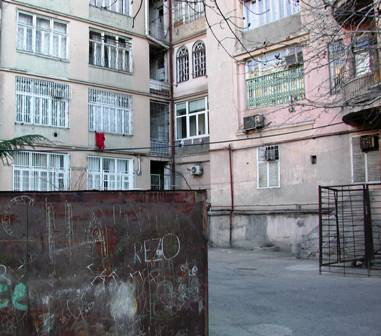
Early Morning, Tbilisi, Georgia, 3:05 a.m.
Flying into Tbilisi is a strange experience since the
Turkish airline flight plan above our heads reads “1:53” for
landing and we know from the American Embassy of Georgia
that we are to arrive at 3:05 a.m. Our ticket reads 3:05
a.m. The thought flashes across our minds, “Did we get on
the wrong flight?” We are not really sure so we ask,
“Tbilisi?”, pointing to the ground, and are happy when the
answer comes back, “Tbilisi”.
But it is so dark. Coming into Paris and Istanbul, the
cities were filled with a flood of lights. This is in stark
contrast. We are not in Kansas, anymore. Toto!
We are met by a man hired by the Embassy to drive us to our
apartment. The car moves silently across bump-filled roads
in semi-darkness, then on narrow streets until suddenly we
stop and are led through a dark entrance with dirty, peeling
walls and broken steps. It is a concrete dwelling with
multiple stories, pre-Soviet design I learn later, but there
is little at this time of night to identify it. We walk up
one flight of steps, open two massive steel doors with four
keys, and are greeted warmly by our landlady, Landia. She is
in her eighties and speaks no English. Our tour person
translates, somewhat. The inside is in stark contrast to the
walk up the steps. It is bright and large. In many ways, it
is our first lesson in learning about Georgia. Never accept
the outside for what is contained inside.
The ceilings are fifteen feet high. There is a crystal
chandelier in the living room. I feel like Gauguin or Degas,
stepping into the 19th century with Anne as my
mistress/model beside me. Everything is old, antique really.
There are two single beds in the master bedroom and the
total apartment is bigger than our townhouse of 1600 square
feet in Waco, Texas. We are so tired by the time everyone
left that we do not have the energy or desire to eat the
bread, cheese, fruits and snacks stacked in the ancient
Russian-made refrigerator.
We sleep like the dead until 9:30 a.m. (all four and half
hours of rest) but we are comfortable, although apart for
the first time in over forty years of marriage. Our bodies
are still exhausted from the trip but our heads are alive
with things that need to get done in the next day, week,
month, and year. We stand in the middle of the apartment,
looking at the 100 boxes of books and other things sent by
American museums, architects, and artists for a Collection
which will represent American art long after I leave in May.
We sit looking at the piles of work and wonder what is to
come next. It is a scene that will be repeated often in the
next nine months.
When we awake, it is to a Rococo bust of a lady, a ceramic
eagle from the 1800’s, some art nouveau vases on top of an
antique twelve foot by nine foot wardrobe, vintage late 19th
century. Now, the windows are open and light is beginning to
own the darkness. Bread, cheese, fruit, and bottled water
are a welcomed breakfast. This is a ritual which will become
routine in our stay in Georgia. I take my morning pills and
go to the study, which is quiet and piled with boxes. I
begin opening the gifts from American architects, museums
and Texas artists. It is Christmas for me. Surprise after
surprise. Michael Graves sent his book, Robert Venturi sent
six and Stephen Holl sent his ideas about what the future of
architecture should be. Holl has just been featured in Time
Magazine as “Architect of the Decade”. The Museum of Modern
Art in New York, Hirschhorn Gallery and Sculpture Garden,
Houston Museum of Fine Arts, New Orleans Museum of Art,
Newark, Albright-Knox, Honolulu, more and more gifts are
opened. I am filled with wonder on America’s help in this
adventure in a new democracy.
Magda, Nata, and Georgi come from the American Embassy of
Georgia to tell me about my duties which will start in
October. I had been told September before I came but it was
not clear even then. I knew about classes at the Academy,
the National University, some other lectures and session
with non-governmental agencies, working with museums,
secondary school talks, and then Nata says, “Oh, would you
mind going to Kutaisi to represent the United States at an
International Artists Workshop where you paint and lecture
for the month of September?” All kinds of questions filled
my mind but all I said was,”Yes, that would be fine. Of
course, Anne goes too.” “Of course, you will be joining two
Russians, two Germans, one Greek, one French, 10 Georgians
and some other artists. All the painters and graphic
artists will complete at least five works, three going to
the Georgian Artists Union and two for the artist. The
sculptors will just complete one work to be left in
Kutaisi.” A thought did appear, “We have just arrived on the
23rd of August and now we leave again on the 27th!”
but I am elated. I came to Georgia to meet other artists,
work at my own painting, and teach new ideas. This is that
opportunity.
In the evening, we try to find a restaurant that I wrote
about before coming to Georgia (my editor wanted all my
Letters from Tbilisi in his hands three months before
publication therefore our first impressions of Tbilisi were
described through images from the internet). Now, we wanted
to go to make the article true. We knew that it was outside
of the city. What we found is that six restaurants had the
same name therefore we choose one below the patron female
saint who welcomes visitors. Her statue is perched high on
the mountain (which I learned later to call “a high hill” in
contrast to the Caucasus). The restaurant is on the second
floor, a large room with numbered tables set up for groups
of ten or more. We look at each other with the expression,
“Did we find a hall which only caters to banquets?” There
were two groups of men already seated at tables, toasting
and singing. We seemed strangely out of place and time, two
alone Americans being seated at a table which was set up for
twelve. “No, it is all right,” said a young waiter, “we are
set up for smaller parties.” Strange, I thought later, that
he should use that word “party” for that is what the evening
became. We order a full bottle of Old Tbilisi wine (thinking
that we had only ordered half a bottle but learned quickly
that nothing comes in halves in Georgia) and settled down to
eating some of the best food of our lives. The supra, an
ancient toasting and drinking ritual while eating, which has
symbolic and real value to keeping Georgia Georgian, was in
full motion at the other tables and it did not stay at one
table. Toasting was done between the tables, across the vast
hall and around each table. The live entertainment was
professional and marvelous, soloists and singing quartets
with piano/organ and a drum. The voices of the singers
rivaled any opera stars.
At some moment in time, another birthday party came in; a
bottle of wine was presented from one table to another,
although it was obvious that except that they were all
Georgian they did not know each other before that moment.
Time was at a human pace. Two and half hours passed
enjoyably, listening and eating. Then a major figure came
into the room, passed from table to table, surrounded by his
subordinates, and slipped away as a whisper in the joy of
the night. Anne nudged me and said, “Godfather”. We finished
the last of our wine, ate the last delicious morsel of food,
prepared to leave when a new bottle of wine of Old Tbilisi
Red was presented from a man at the table in the corner. We
blew each other kisses, a universal symbol that transcends
spoken language, and settled back for a longer evening. We
had never drunk two bottles of wine at one meal.
Later I found a waiter who spoke some English, got some
Xerox paper to draw on, went over to our host’s table and
drew his portrait. He had a strong, robust smiling face. We
were no longer strangers in that moment. People at the front
table, seven men and one exquisite young woman in a red
dress, were gathered around an enormous, lighted birthday
cake which had been brought to the table with great
ceremony. The men got up to dance together. Finally, the
birthday lad and the young woman in red danced to a slow
Georgian tune. It was hypnotic; the two of them were ballet
dancers in their own realm on a stage made just for those
two. The graceful movements of their hands, arms and
intrigue steps were a thing of pure joy. I had never seen
such beautiful dancing except on a professional stage and I
had looked the world over for this kind of beauty. Matisse
would have envied my vision at that transfixing, magic,
extended moment. Others cut in to dance with the lady in
red, then she sat down and two men locked arms in dance.
Finally, our objectivity was broken when some young men
asked us to join in the dance. We did. It was not the beauty
that I had seen with the lady in red and the birthday lad
but that was not what the party had asked us to do. All they
ask was “join in the dance”.
When we left the hall that first night in Tbilisi, full dark
night had come once again upon the city and this new outside
world. It was the same dark that we had encountered when
driving in to our apartment for the first time but somehow
it was totally different. Now, the dark was a cloak that was
worn with a smile, warm and friendly. We had been the
“honored guests” in this new nation.
It is Sunday now, the day before we leave for Kutaisi. I go
to the lot behind our apartment to unload our trash cans
into the four large containers. I just make it in time as
the garage truck is loading. The men are so courteous and
helpful. I have two loads of empty boxes and they help me.
They carry the loads and somehow communicate that “Is that
all?” As I walk back to the second floor, six men work on a
disassembled motor, another dressed as a chef unloads fresh
meat from the trunk of his car and cuts it on a large tree
cross section, and two boys play war games with toy machine
guns and a toy rifle. Each bobs his head, “Good morning,”
except the boys who are winning their own imaginary war.
Later, I find that the taxi drivers are tolerant of
“non-Georgians”. I give them another address for one of the
six restaurants with the same name and they try to make out
where we want to go. None speak English. We speak no
Georgian. One driver went in the opposite direction at first
until he realized his mistake (or our mistake in writing the
address) and still we were charged the normal 5 lari ($2.50
USD).
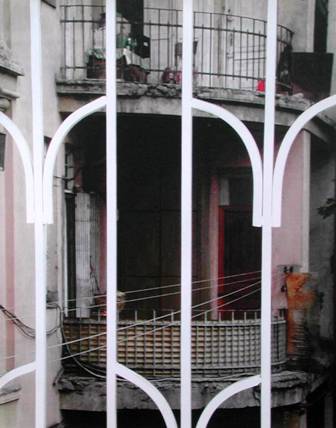

October, 2001: Letter From Tbilisi: In truth, this
letter should be titled Letter from Kutaisi, Georgia. After
arriving in Georgia, we were invited by the Fifth Annual
International Plenary for Artists to come to Kutaisi and
paint five works of art, two for myself and three for the
Georgian Artists Union. I am the first American artist to be
invited and participate. It is such an honor and opportunity
that I jumped at the chance. Anne and I would see parts of
Georgia that no Fulbright Scholar or American had seen
before and at the same time live and work with twenty of the
best artists in France, Greece, Germany, Russia and of
course Georgia (10 sculptors and 10 painters/graphic
artists). As an added gift, Anne and I were asked to be the
guest of the Governor (and his wife Dea) of 14 Western
Georgia districts, Mr. and Mrs. Shasheashvili..
Nine of us left Tbilisi by bus, sent by the Municipality of
Kutaisi, the old capitol of Georgia. To say that the roads
in Georgia are bad is the largest understatement that I can
make in these letters. It did not take long for the beauty
of the mountains and valleys to make us forget our
backsides, the luggage sometimes coming down the aisle and
the slalom-driving to miss the potholes that could stop our
adventure. Also the warmth and comradeship of the other
passengers makes up for the lack of smoothness. We stopped
to eat warm bread, khachapuri (a bread with cheese inside)
and fresh cheese that rivals any in the world. We drove into
the towering mountains for five and a half hours before
reaching Kutaisi, a much smaller city than Tbilisi. Cameras
for television and newspapers greeted us, as well as the
Governor, the Mayor and other district dignitaries. It does
not take long to realize that one must wear several hats at
these international events: artistic, political and social.
It takes a juggling act to shift roles but it is essential
to understanding the situation.
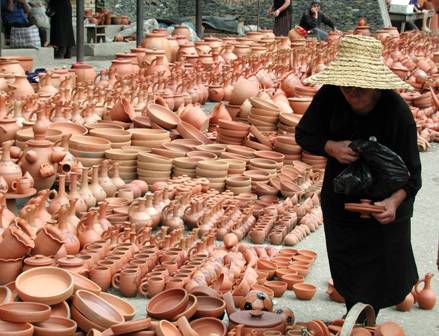
Soon after the individual and group photographs were taken,
we were escorted by the Governor’s driver to a modest home
at the outskirts of the city (it had been his parent’s
house) and first met Dea, his wife, who would become a
friend and companion over the next month while we were in
Kutaisi (which ended up for only two weeks since we took
side trips to places where no Americans have gone, the high
mountains). That night we were the honored guests at the
annual religious ceremony at the 6th century
reconstructed church high on the mountain protecting the
city. Everyone walked behind the golden icon of the Virgin
through the winding, cobblestone streets to the church.
Later, we had our opening banquet which started at midnight
and ended at 7:30 a.m.with wonderful food, drink, toasting
(it was our first real extended experience with the Supra,
the Georgian ritual of toasting by the men), dancing and
singing. We only made it until five in the morning but when
we left the party still was alive and spirited. The Governor
was the tamada (the orchestral leader of the Supra) and was
brilliant to watch, making sure each of the 40 participants
were honored, had a voice and given the correct time to
speak and be heard. He had to mix humor and wit with
seriousness, music and dancing with the toasting. It was
masterful to watch. And also he had to drink more than
anyone at the banquet since he was the leader who honored
all. I do not know many American leaders who could shoulder
his role.
I attempted to figure out the schedule but only found that
we ate at nine, three and nine o’clock because the sculptors
needed the light to work. Many of the first few days were
spent with a “hurry up and wait” pattern. When Dea asked us
to go to the Black Sea for the day, it was a welcomed break.
The sand was black, the water warm and the company
delightful. On returning I found that I was leaving the next
day to go to Kharagauli with two other painters and Anne. It
was a rare and wonderful trip, high in the mountains, filled
with breathtaking scenery, visits to artists and farmers who
not too many foreigners get to meet, and welcomed by a
hospitality that is second to none in this world. We ate at
Sasha’s small house (no more than fifteen feet square) and
he gave us all that he had (with the Supra of course). The
poverty in Georgia is widespread but the pride in country
and giving to an “honored guest” is a long and respected
tradition. One plate is always left empty just in case a
guest might arrive. I got to see David Sakwadzef, the
district manager of Kharagauli, ride like John Wayne, tall
in the saddle and comfortable on a horse. I finished eight
paintings, after driving over non-roads, fifteen streams and
car-size potholes where the water came halfway up the tires
of our Russian army jeep, so I can take a day off here and
there to visit other magnificent places. The economy and the
road are poor but the people are rich in spirit and live in
one of the truly beautiful countries of the world. The
economy will change. New leadership will make sure it
happens but only because they can build upon a foundation of
centuries of tradition, a fierce pride in nation and the
warmth of a people that overcomes many adversities. I will
miss Kutaisi when the final exhibition opens and I return to
Tbilisi for teaching but I will plan to come back during our
year because friendships have been made.
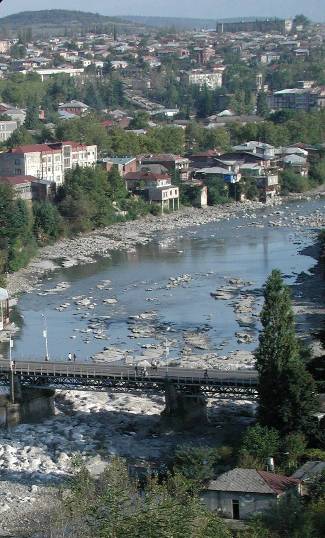
Kutaisi, Georgia: The International Plenary Workshop for
Artists and Sculptors:
A rooster crows in the distance, returned by another cry in
the opposite direction, a cow moos to the morning, a few
sounds of children break nature’s symphony or add to it, and
the flapping of pigeon wings are all the sounds that great
my awaking in Kutaisi, Georgia. In the distance, the city’s
cars made a soft rumble as this city of 300,000 awakes too.
The sight of a straw hat appearing over the hedge in the
distance tells the story that the farming community has been
awake long before my stirring. Now, a few voices join the
concert sounds, accented by the chirping of crickets.
Visually, the mountains ring the city. I sit on the rough
concrete balcony of the Governor’s house and feel the cool
morning breeze wash my skin. It is 9:00 a.m. For me, that
seems like getting up late, but if you party collectively
until 5:00 a.m. then this is early. The Kutaisi Georgians
are the crown princes of partying with speeches and toasting
(the supra), food, food, food, singing, dancing, more food,
drinking (no glass goes unfilled) and music (a trip of
voices, saxophone, piano and violin). That was the opening
banquet held by the Georgian Artist’s Union and the Governor
of the Western Section of Georgia. It started at midnight
after a religious service at the 11th century
church (started construction in the 6th century)
where Governor Shashiashvili and priests presided. The
city’s icon of the Virgin Mary was carried up the mountain
(“high hill”) to the cathedral without a roof. Anne walked
the whole way with the procession, up the winding,
cobblestone streets. I drove, resting my bad knees.
We arrived to a press blitz, had pictures taken and were
whisk off to the Governor’s house. His wife Dea greeted us
and we ate the first of two meals before the midnight
banquet. As an artist and a man, I was struck by her beauty
and graciousness. I tried to draw her but it was not even
close. I had brought a tiny sketchbook for portraits where I
would draw the face and the model would sign in Georgian and
English. I did not ask her to sign that drawing. Later, I
would do another. I did start a small series of portraits of
the other eight artists who came with us in the bus. It is
my visual memory devise to learn names and tie them
permanently in my mind with every feature. I drew some other
portraits at the banquet last night.
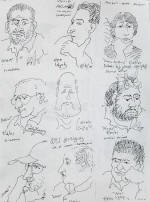 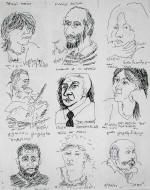  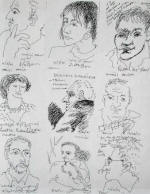
Anne tells me that breakfast is “prepared”. Breakfast is
never “ready” but it is a major preparation. As I leave the
balcony, the city comes more alive against the panorama of
the breathtaking mountains. I hope to learn the schedule for
the artists today but I have learned already that “things
come as they come in Georgia”. There are things that are
sure: there cannot be any other people in the world who work
so hard for so little and party so hard for much!
I meet with a group of artists for lunch. We discuss many
things through two or three languages. The artists have
impressions of America that differ from mine. The discussion
centers on our “old democracy” and their “new emerging
democracy”. George, the sculptor, points out that each time
the president changes here the system changes whereas in
America the system stays the same and the man at the top
changes. We discuss the “corruption” of government in
Georgia. We discuss how the infusion of American’s dollars
into any economy that is just beginning creates the idea
that “money will solve everything”. One fear that George has
is the environment. How can Georgia come into the 21st
century and still keep the beauty that is this special
place?
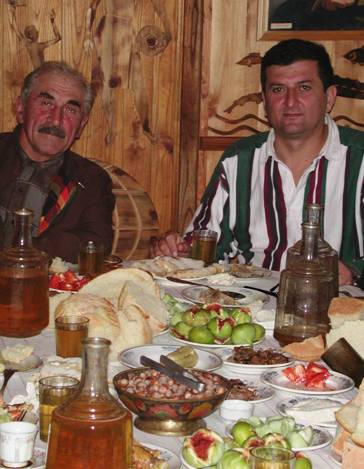
After a week of hard painting, we drove to the Black Sear
and black sand with Dea and her children, the two German
artists and our driver from the Governor’s office. After
laying in the shade, with the roasting sun turning the sand
to hot coals, I ask Dea’s daughter, Nini, to write “sky,”
“water,” and “sand” in Georgian and I copied them upside
down (a trick I learned when studying counterfeiting of
signatures). Now I must put them back together in some kind
of structure that pleases me and captures the love that I
have for the visualization of this special alphabet (being
one of the fourteen languages of the world and only used in
Georgia). I drew:

As the heat intensifies and the burning sand stops all
walking in bare feet, a vendor comes by. I ate two ears of
corn as a snack. It was so fresh, tasteful and delicious
that I think “it is a shame to only serve it with a meal as
we do in America”.
After another bumpy ride home where our backsides ruled our
minds, Anne and I wish to walk a little in Kutaisi. It is
raining. We have no umbrella and are soaked as we journey to
the studio to get instruction for the next week. We are told
that we “must” go into the mountains for “five
days”. I expect Renoir or Monet to bring canvases for
the extended outing. We should ask Seurat too, I think. Oh,
how the thinking about art and contemporary concepts are
non-existent. Down below the two Georgian artists bring
canvases and rolled paper. This is a far concept from my
laptop images from my digital camera for details and my
sketchbook for concept images.
The way that I work is gather information. Actually, that is
how Renoir, Monet and Seurat also worked except that they
did not have a laptop or they would have used it.
I gather information in the quickest way possible- sketches,
photos, color studies, ideas in words, and then I come back
to use this material which emerges from the ideas in the
field. Reality has changed since the 19th
century. Not Nature herself, but how man collects
information. It is no longer reality which is only outside
the eye but also what we know, what we dream and what we
imagine. Sadly, that kind of thinking is called “foreign
influence” and “liberal” and “American”- even when a
Georgian artist does it. For now, sitting on the balcony,
waiting to leave for the mountains, we wait, we wait, we
wait. There is no schedule. In Georgia, it has not been
invented yet.
Kharaguali, Georgia: We had dinner at the Kharagauli
district manager’s home. Once again, the food is delicious
and abundant. We toast to America, Georgia, family, parents,
grandparents, art of Georgia and the world, the artists from
all over who came to Kutaisi, Kharagauli, peace,
Shashiashvili and a special toast while drinking from the
“singing goblet”. The goblet is filled and as you drink it
slowly song comes from it, a long Georgian chant from the
past. The competition is to drink until the song is almost
over. It takes practice and the more wine that you drink to
practice the worse you perform. David, the manager, has five
children, one son and four daughters. The girls sang three
Georgian songs as we ate and they sang like angels. When we
returned to the hotel room (kept for those who came to give
or get from Kharaguali), my head was light as I sat on the
edge of the bed but my body was too heavy for the weak
boards holding up the mattress. It crashed to the floor so
we slept in the other single bed. There was no electricity
so we lit a candle. During the night, since the holder for
the candle is some kind of plastic that is disguised as
metal, there is a fire in bathroom. Anne puts it out as I
sleep.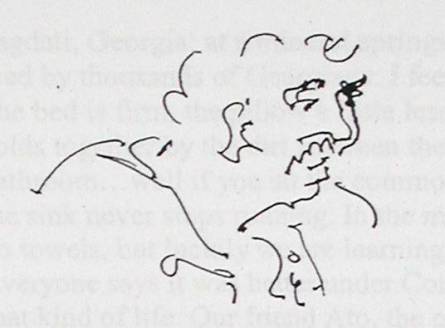
High in the mountains (much higher than we
went yesterday in a standard jeep) in the chill air,
in the home of an artist, in the village of Leg-wani,
we sit around a carved table, nine men and Anne,
surrounded by art inside and beauty without.
I can see why this talented man returned to the
mountains to work.
We drove on and come to a point as high as I thought we
would go. We arrive at Borjami-Kharagauli National Park
(halfway to “Iron Crest”) which is only part of our journey
that day. “The road gives out,” we are told. “Iron Crest is
six miles further up the
mountain. We have crossed fifteen white-foam,
rapidly-rushing, shallow streams and countless holes in the
dirt “road” filled with water that come halfway up the tires
of our Russian army jeep. The pride that the Georgians have
in their land is everywhere. Java, a Georgian painter from
Kutaisi, started a canvas using a clump of trees as his
subject. I paint a color study. No one paints the grandeur
and majesty of the towering rounded mountains. One can see
where the curves and rounded letters of the Georgian
language come from. Later, we stop at Sasha’s small farm.
All the houses and work sheds are hand-built with simple
rough wood. His home is elemental with three rooms- two for
sleeping and one for general use. One of the sleeping areas
doubles as a place to eat. Sasha and his neighbor, Robert,
give us the best that they have: bread which they bake
themselves, another bread made from potatoes, homemade
cheese and wine, and khachaburi (a bread with cheese
inside). We eat and toast for an hour and a half with Sasha
and Robert speaking passionately about Georgia’s future. As
Robert says, who is in his late seventies as is Sasha, “All
we have here is hope.”
The contrast between the unbelievable beauty of the
mountains of Kharagauli and the believable poverty that is
so obvious is something that all Americans should see. Even
the man with so little (except hope in the future) shares
all he has with strangers. There is a wonderful tradition in
Georgia of leaving one plate empty at the table for the
guest which might come. There is so much richness in the
daily life of Georgia that I want to drink it all in.
Back in Kutaisi, we go to visit a woodcarver’s collection.
He died four months ago. When we arrive, there is no light,
no electricity therefore we view each work by candle light.
It is an enjoyable way to view works of art. You have to
concentrate on each creation and remember its detail to
compare it to the next work of art. Later, the lights came
on, the Governor’s wife, Dea, called the electric company.
The next day, we visit the Kutaisi Museum and the
electricity goes off again in the middle of the viewing. We
have to feel our way to the exits in the dark. One of the
smartest things that Anne brought was a flashlight.
Bagdati, Georgia: at a mineral springs retreat built by the
Soviets and now rundown but used by thousands of Georgians:
I feel rested but it comes in two to three hour sequences.
The bed is firm, the pillow a little less than concrete with
a soft cover, the wood floor holds together by the dirt
between the boards which tip up as you step on one end, the
bathroom…well if you sit the commode your knees are under
the sink, and the water in the sink never stops running. In
the mountains, there is no short supply of water. We have no
towels, but luckily we are learning and brought one. Life is
at its elemental again. Everyone says it was better under
Communist rule but no one speaks of going back to that kind
of life. Our friend Ato, the painter from Kutaisi, has a
gallery in Milwaukee where he sells a few paintings a year
that keeps him, his wife and a child, his mother and an aunt
surviving. I have learned that is the key word in Georgia-
“survival”, except for the politicians and a few businessmen
(some say ex-Communists who got theirs before the change
happened in the country), all driving BMWs and Mercedes. I
am asked by a reporter from Batumi, a city in the lower
southeast corner of Georgia, “What do you not like about
Georgia?” I sidestep the question by asking her, “What do
you not like?” The young highly-educated reporter says, “The
bad roads, no electricity, no water, no hope at times, and
my salary, 30 lari a month. How can anyone live on $15.00
USD a month?” “You have answered your own question then,” I
reply.
Yet again, in all this, the people love art, country, their
traditions (which have survived through occupations by the
Persians, Turks, Mongols and the Communists from Russia),
their unique language, and one of the most beautiful spots
on the face of the earth (although only seven percent of the
earth is good for growing things). There is a zest and true
love of life which is refreshing while at the same time
there is a deep sense of seriousness. The colors of this
land are black mixed with bright red and white. It is Death,
Blood and Hope, which are the colors of the Georgian flag.
To Color and Form
September 2001: Hundabe Valley, Kharagauli: “Creation of art
is not a duplication of what most people call “reality”- a
distant view. It is close and far, what I see and what I
know is there, the color on the surface and the color coming
through the surface, and what is in the distant view and
what is in the air between the eye and the object.”
To mountains and Landscape:

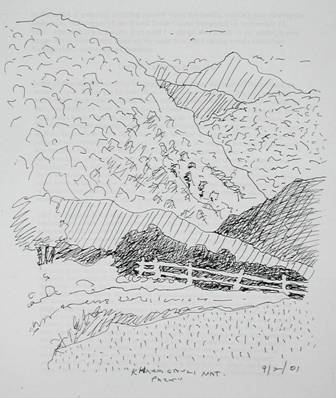
In the midst of painting, drinking mineral water for
health, walking and viewing the mountains, the tragedy of
the World Trade Center happened on September 11, 2001.
Although it was several days until I could get this article
to my editor, it was important to write it and make up my
mind how my painting would reflect my feelings about
terrorism and freedom.
Cut Off, Yet Seeing From Afar
In the 20 days that we have been in Georgia, the electricity
has been off for ten days, no water for seven and no gas for
four. Here in the mountain region of Bagdati, a mineral
water resort (since most Georgians cannot afford medical
care), high above the world, we had no electricity for three
days. There is no email or internet and all cell phones do
not work at this height. One can call out but the line for
the one telephone is prohibitive. Therefore last night when
the lights went on and the candles were put away, a cheer
went up from the hundreds in the dining hall. Later we went
up to view the one television (the language was Georgian of
course) and I saw in horror the image of the burning,
collapsed and torn twin towers of the World Trade Center.
The image was clear and understandable, although the only
word that I understood in the Georgian subtitles was
“terrorists”. (some words bridge both languages). I watched
the images from the universal screen, the television, and
found the anger rising within me. All I knew was that some
terrorists had attacked my country (two cities, New York and
Washington) with the weapons of international terrorists:
fear and violence. It was planned for maximum television
coverage and maximum emotional impact.
I did not sleep much that night, replaying the images in
same manner that that the fourteen-inch screen had done
earlier. The strike on the twin symbols of America’s
economic power had been high up, telling us that no place is
safe now. Still not sleeping, I reviewed the two pieces of
information and thought that I might not get more data if
the pattern of no electricity continued (it did). My major
thought in the night, so far from America, was: “We cannot
allow these fanatics of fear to change our way of life, the
freedom that so many through the years had died to defend”.
One of our strongest weapons is our freedom itself. They
attacked our basic resources: world trade and business, our
symbol of Democracy (Washington) and our elected and
military leadership. We may not be free from caution or
safeguards but we can be free not to choose fear as a
response. My Georgian companion asked, “Why did your country
not kill the terrorists, wherever they hide, before they
acted?” My Georgian was poor and his English was not up to
my complicated attempt at an answer. In the middle of the
night later, I not only wanted to wipe out the leader behind
this act of violence but wipe out the fanatics’ names - no
identity for history, no recognition and certainly no
television prime time. George Orwell taught us that those
who write history create history. We Americans hold
individual life and property as a precious gift. We are
shocked at those who throw away life as if it does not
matter. It is strange having only bits and pieces of news,
or worse no news since the electricity is always
questionable. As a people and society, Americans have
instant everything, including more news than our minds can
handle. Here, I have minimal or none. And when it does come,
it is through limited translation.
In the midst of a long, dark night, I asked myself: “What
can I do as an American abroad to support our belief in
democracy and freedom?” The answer was swift and clear. I
came to Georgia to tell others about America, especially
American art and architecture. Right now, in the mountains,
I am the American representative at an International Plenary
of artists from many nations. I will paint with the
brightest, strongest colors that my freedom allows. I will
not give in to black and bright red, death and blood.
Later, many Georgians came up to Anne and me, touched their
hearts and said, “Sorry”, one of the few words in English
they knew. I replied, “Thank you very much,” one of the few
phrases in Georgian I had learned. Here, a people with so
little extend to me- the only symbol of America in these
remote mountains- their sorrow on our national loss. I am
moved deeply. After a long wait and help from a Georgian
artist, I talked with the US Embassy about our safety and
was told to stay in the mountains a few more days.
Therefore, we remain at a place where there is little or no
communication with the outside world and the one television
for two large “hotels” worked only a few minutes to give me
a lasting image to ponder. I would say for all of us to
ponder.
After waiting in line for the one telephone for over 1000
callers, I contacted the American Embassy of Georgia about
our safety. A special meeting was being held in Tbilisi for
the American community in Georgia but there was no way that
we could make it on time from the mountains. Also, we were
told by the Embassy staff, “Stay where you are for a few
more days. You are safer there than here.” Therefore I
returned to painting and writing in my daily journal. I
reviewed what we have seen and create two other segments of
the December exhibition.
To Soaring and Joy
“Birds fly in great sky
circles of freedom
How do they learn this?
They fall
And having fallen
They are given wings.”
“May the Beauty we love be
what we do.”
Jelaluddin Rumi, 13th
century Islamic, mystic poet who believed that we all are
brothers.
I discuss in my journal that relationship of color and
form to the mountains. Also I think about the relationship
between the abstract qualities of these natural structures
and the forces that are at work within me. Later, I found
these words by David Kakabadze which I will use for this
celebration exhibition:
To Color and Form
In 1921, Kakabadze wrote:
“Art should not present what exists, but what is possible to
exist.
Art is as solid, as more it
describes unexpected events.
Possible plastic art, which
does not remind us of existing natural shapes, but by its
inside character inspires possibilities of nature.
Plastic forms exist, without
telling any contents.”
I find today that I am a
brother to Kakabadze in spirit, not really separated by
eighty years. I keep a photograph of him, taken in 1950,
that shows his love of life and Georgia. I celebrate his
joy.
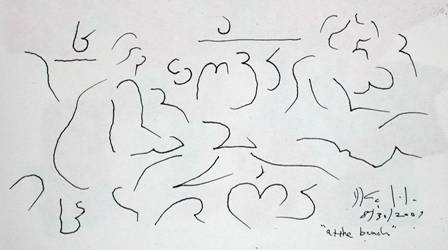
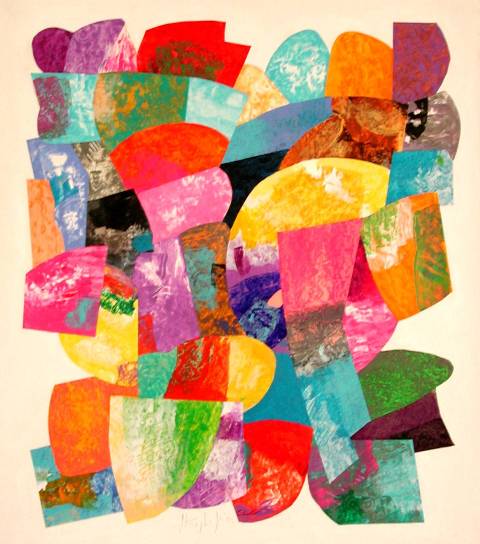
As Anne, Java, Ato and I walk down to get the “after meal”
mineral water, an image appears across my mind’s visual
memory. I am six. It is 1938. I had to tend the tomato
garden in our backyard and I look forward to eating liver
pot pie for dinner. Many men are out of work. Fortunately,
my father has his job as a milkman. Everyone is poor so no
one knows that they are poor. Later as I grow up I decide
never to eat another tomato or a cucumber (also growing in
that tended garden) as a protest again that time in life
when that was all that we had at breakfast, lunch, dinner
and as snacks. In Georgia, I again eat tomatoes, cucumber
and, sometimes, liver!
I am reading Edward Hall’s “Beyond Culture”. It should be
standard reading for any Fulbright Scholar. We see daily
examples of the clash between monochromatic-time (Western
ideas and schedules) and polychromatic time (the Georgian
hold on the past and non-scheduled activities, even when
scheduled). Our waiting time in Kutaisi is understood now,
frustrating but understood.
Again, back in Kutaisi, we attend a Georgian play. The
dancing and singing are wonderful. The play is a symbolic
and predictable saga of Georgia’s march from Communist
“blindness” to freedom. It was written in 1987 and banned by
the Communists. As a critic, this banning of the play is the
only reason that it lasted this long. My German painter
friend, Claus-Peter, and a Georgian artist only could take
one act. We stayed the whole time. You can learn much even
from bad plays. I am writing this on the porch of the
Governor’s house, where five families live, with no
electricity or water again. This condition has continued for
the last eleven years since independence. In some ways, the
Georgians are still blind to solutions and accept the
circumstances. This real play will also last until there is
a cultural outcry and the blinders are taken off. Drinking,
toasting and talking will not change a situation of no
electricity and no water. Only action will make a difference
and that means figuring out how to obtain the political and
financial resources to create change. There are those who
see, as there were in the play, but they feel that nothing
can be done in a corrupt system of government. And some, who
prosper by the misery, do not want change.
More reading of Edward Hall’s book gave me an insight into
the lack of color in this society. Hall discusses the
working of the human eye: cones in the center which are the
tools to make fine color distinctions and rods further out
which distinguish movement. If you are being confronted
daily by things (automobiles, strange characters, etc)
coming at you from all sides at once, you use your rods more
than the cones. This society has always been attacked from
all sides and still is. Walking the streets, cars come from
all directions without reason or a system. I have found that
stopping for a red light is only honored by some, sometimes.
Again, Hall gives me more insights. Anne read me a section
about the Arab’s “spite walls” in Kuwait. In two instances,
an Arab was offended and took years to buy the land around
his victim’s home. When the land was all purchased, he built
a high “spite wall” around the neighbor’s house so that the
offender “could not see the sea or the world around him”.
That is the intent of Osama bin Laden, using his terrorists
instead of a spite wall, to America today. He is trying to
change how Americans see the world around them. He is
attempting to wall in freedom.
It is another early morning, just me and the roasters
crowing. In the east, the warmth of the colors of morning
begins to fill the sky. I did not drink last night at the
supra, a five-hour banquet. As I see beggars on the street
and people living on bare existence, it is hard to watch the
abundance of food and drink that is laid out at each banquet
of those in positions of power- politicians, lawyers,
educators, doctors and others. We have had supras in Kutaisi
with all of them, in fact 40 supras in 30 days. I believe
that I understand the guest-host relationship and traditions
of Georgia. As the vice Governor said last night, “If you
are the host in the house, then no matter the relationship
with your guest- friend or enemy- it is an iron-clad
tradition that you offer the guest wine and food while he is
under your roof.” That is a marvelous tradition and a model
that could be used for the world, but the national scene in
Georgia is such that the people are suffering. Aren’t the
people of Georgia a guest in the house of the politicians?
True, a nation must take care of the stranger but I see
estranged citizens becoming strangers in their own land!
Edward Hall writes, “Man has a personal relationship with
everything. What one needs from life is power, but that
power can be used or find its way only in certain
directions, which are set by the karma of the individual.
Hunters relate to one cluster of particular substances,
while men of knowledge have another set.”
On the day before leaving Kutaisi, we were asked to visit a
dance class. We went to the where the sculptors work and
wait for our guide to the dance studio. No one comes at the
appointed time and just as we are ready to leave, a voice
behind us says, “The dancers are now ready.” We are lead
into a small room, hot with no air conditioning, with about
thirty young dancers waiting on benches as we come in. At
once they applaud our entrance and stand up. We are the only
audience and they are magnificent. I see where the great
tradition of quality dance in Russia and Georgia comes from-
two seven-year olds hold themselves erect and then move like
seasoned, professional, ballet performers. The headmaster
(and he was that) holds a stick and is not reticent about
using it to show correct form and a straight back. Again
quality comes from this kind of enforced discipline. He also
kisses and hugs the children when they excel.
That evening we drive with Dea and Governor Shashiashvili in
his Mercedes to the Conservatory for a concert. The music
again is superb, first class in any culture. The conductor
is from Tbilisi and has spent a year conducting in America.
As the light dimmed outside and no electricity inside, the
next to last piece by a Georgian composer is performed by
candlelight. The last piece of the evening has to be
cancelled. As Anne says, “It almost brings tears to see this
serious pursuit of excellence in a country where they cannot
afford electricity for excellence.” Our hearts go out to
these fine musicians who make little or no money as a
professional and to the audience, packed to the standing
room, who endure the heat and concert by candlelight. Just
when I think that I see and understand Georgia a day happens
like this, filled with wonder and superb beauty and tragedy.
Yesterday, I taught a two hour class at the Kutaisi State
University to about thirty students who were studying
English. My talk was called “Freedom and Creativity”. We
played creative games, audience participation, discussions
and I gave a straight lecture. Some professors who attended
said that my style was different than what they were used to
under the Soviet system. That system had been a formal
lecture and then a few questions. I gave no less information
to them but not a formal talk without their participation.
Learning for me is a joint activity between teacher and
student where the object of the teaching is to make each
student his or her own teacher. We discussed Georgia’s
problems with democracy and I told them right off that
America or anyone from the outside could not be the
solution. They could be an asset, an aid, but never a
solution. I was asked what I thought were the resources that
must be in place to make change. I was reticent to say, only
being in Georgia for a month, but I was pushed to say what a
consultant might recommend. I said, “Leadership, vision,
building upon natural resources, the use of the vote to oust
elected official who do not serve the people, the use of the
vote to create change in the people’s best interest, and the
use of outside sources that need Georgia’s riches.” They
asked what to do about corruption. I told them that it was
an internal decision that only they could make with the help
of their elected officials. One girl said, “Our elections
are only the show of democracy, not true voting.” One boy
said, “We have no models. How can we solve the problems?” At
this, I laughed and added, “Who knows one resource, which
could be a solution, which Georgia has in abundance?” After
a short silence, one girl said, “We have water.” “And all
over the world, water is used to make what?” “Electricity”
was the choral response. I told them about meeting a farmer
who had harnessed the power of a stream in the mountains for
his saw mill. He had electricity all year round for the
saws, sanders, grain pounders, and enough left over to send
it to his home on the mountain. He was never without
electricity. He had their answer in microcosm. I left after
signing autographs (a new experience for an American
teacher) and went to the opera house for a final performance
before we left for Tbilisi. It was like a Kennedy Center
tribute to performers but instead of six artists being
honored it was one. She was a singer who had worked at the
Met. A younger opera star, now singing at La Scala in Milan,
gave a magnificent tribute in song, and accented it at the
end with flowers for the honored guest. Anne and I attended
the final banquet for the grand lady of the opera. It was a
banquet for one hundred friends with toasts, food, singing
and dancing. I drank water and no one cared. It was a
glorious day in a series of days that can be called “best”.
Driving back to Tbilisi in an American Embassy car, I
considered what I had learned in Kutaisi. I had seen
Georgian social, country club life, the political world from
the home of its leading politician in Western Georgia, the
problems of the artist in this politically-charged setting,
small villages in the mountains, farmers who gave all that
they had to a stranger from America, and had seen places
high about the valley floor that few Americans have had the
privilege to experience. I attended dinners in a cramped
setting on a mountainside in a hut for one which held four
people, in artist’s homes, conferences of doctors, lawyers,
scientists, educators, performing artists, children’s school
administrators, University professors and many, many more.
We attended supras until the wine became too much. We lived
with the Governor and his lovely wife, Dea, for a month. We
do not even live with our children now for that long. We met
business leaders who are trying to expand the bounders of
Georgia through commerce. We knew judges who painted,
painters who were trained as scientists, leading doctors and
educators who recited poetry at the supras. And we had seen
Georgia’s common man close up in the city and the mountains.
We were the official Americans at every event we attended
(two or three per day). We were the only Americans in
Western Georgia for that time. I was interviewed over twenty
times in the thirty days. We learned about sacrifice,
dedication, pride, tradition and the Georgian love of art,
all arts. I read Edward Hall’s “Beyond Culture” as I was
experienced a culture beyond my own and it was the right
moment for that insightful book to give a framework and
perspective on what we saw and felt. Mostly, we survived,
endured, learned, enjoyed, transcended together and got the
best preliminary education about Georgia that we can be
imagined. When we drove into Tbilisi, both Anne and I
commented that this time we are coming in with a fresh
attitude. This is now “home” for eight more months and the
darkness is not as frightening as the night we first came
from the airport.


Shortly after returning to Tbilisi, after my month of
work in Kutaisi, I was asked to have a December exhibition.
Almost at the instant when the idea was presented to me, I
began to think in terms of the things that I learned in my
first few months in Georgia and the one thing that stayed in
my mind was the supra. For me, it was more than a drinking
ritual; it was a way to celebrate all those things which are
important in the life of a country and an individual.
Therefore, the idea of An American Supra started as I
considered all the resources that I use in my art work and
feel are important in life. Groups of paintings were
dedicated:
To Play, Childhood and
Family
To Love and Freedom
To Georgia and America
To Icons and Tradition
To Mountains and Landscape
To Color and Form
To Soaring and Joy
To Death and Those Who Have
Died
To Heroes (Like David
Kakabadze)
To Life and Being Truly
Alive
Since this Fulbright (to
Georgia) was my second and the first was 36 years ago, two
sections of this exhibition dealt with themes that I had
explored at the time of my first Fulbright to Taiwan; Death
Is All The Time, a book painting which I created in 1963 but
published in 1975 and a book I purchase in the early 1960’s
that has sustained me for years in my creative work, Les
Dejeuners by Picasso.
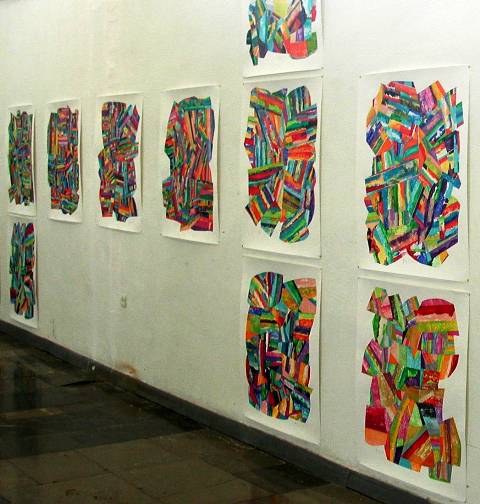
To Death and Those Who Have
Died
Shortly after my marriage in
1957, I learned that my wife’s grandmother had lost 44 of 48
relatives while under the Nazi regime in Hungary. I acquired
army photographs of the concentration camps and studied them
for several years, not being able to divorce my feelings
from the forms that jumped from the pages. In 1963, I took
time off from teaching to give full attention to creating a
work of art in Phoenix, Arizona that dealt with all the
aspects of death that I could think of at the time: from
microscopic to macrocosmic death. I worked twelve to
fourteen hours a day, completing over 2500 drawings in one
year, and completing 169 finished drawings for Death Is All
The Time, a book painting (which I finally published in
1975). During the working on this work of art, Jack Kennedy
was murdered in Dallas. Since I knew him, he was included in
the work under the title “Death of a Young Man Murdered”.
The intensity of the work in 1963-64 forced me to examine
the opposite point of view. That work was called In Summer
When Butterflies Don’t Even Die. As artist in residence for
Washington State University in Spokane, Washington, I
exhibited all the drawings from these two series in 1965 (a
little over 300 works of art). They caused a stir in the
community. I decided to wait to exhibit them again until the
times were able to see them for what they were: examinations
of two extremes in life. Much of the work that has been
completed since that retreat in Phoenix has dealt with the
Butterfly approach to life and being truly alive. The work
since 1978 consciously exalts the wonders of life.

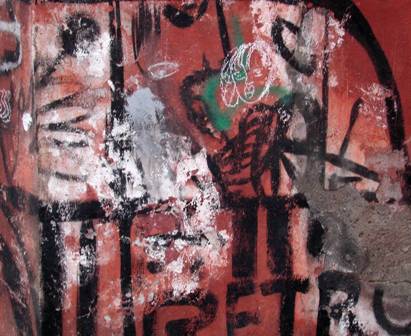
To Play, Childhood and
Family
In 1962, as I finished my
fourth year of teaching in Pennsylvania, I acquired
Picasso’s book of drawings called “Les Dejeuners”. It never
changed my drawing style (Matisse had long ago done that)
but it made me conscious of the need to play with form and
ideas. Picasso was an old man but in that framework lived a
child at heart. Now as I reach a similar time in life, I
give homage to this child! Picasso had taken Manet’s
“Luncheon On The Grass” and spent two years just playing
with one idea- from 1959 to late 1961. My work at times is a
commitment to play.

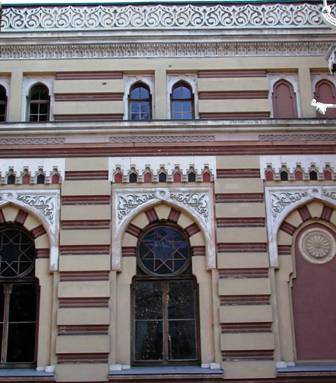
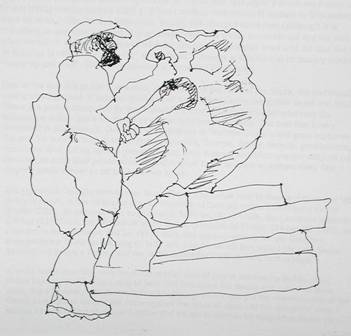 |

